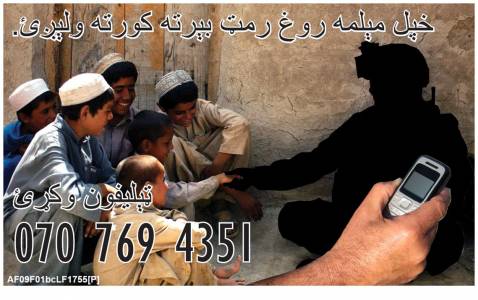|
|
|
The US military released flyers in Afghanistan’s eastern provinces of Paktia and Ghazni asking Afghan citizens to help find a soldier missing since June 30. Photo from AfPax Insider, click for more photos. |
A senior commander in the Haqqani Network has threatened to kill a captured US soldier unless Coalition forces end operations in two districts in Paktika and Ghazni provinces in eastern Afghanistan.
Abdullah Jalali, a spokesman for Mullah Sangeen Zadran, who claimed to have captured the soldier in late June, said the US military must end the search operations in the Giro district in Ghazni province and the Khoshamand district in Paktika or the soldier would be killed. Jalali made the statement in a telephone interview with the Associated Press.
But Jalali also said the fate of the soldier will ultimately be decided by Mullah Omar, the overall leader of the Taliban in Afghanistan and Pakistan.
The US military has launched an intensive operation in eastern Afghanistan in an effort to recover the soldier, who went missing on June 30 after leaving a small combat outpost in Paktika province along with three Afghan soldiers. The US has designated one platoon per battalion throughout the eastern theater to search for the soldier, who has not been named.
The US military has continued operations in Paktika and Ghazni. Just last night, US and Afghan forces captured nine Haqqani Network fighters during raids in Paktika and neighboring Khost province, another Haqqani Network stronghold. Combined forces also detained a Haqqani Network fighter in Ghazni province on July 12.
The Haqqani Network took credit for capturing the soldier and Sangeen said he was willing to conduct “a prisoner exchange” as terms of the release. The group claimed the US soldier was drunk.
“Five days ago, a drunken American soldier who had come out of his garrison named Malakh, was captured by mujahedeen,” stated a Taliban website. “He is still with mujahedeen.”
The soldier is probably not in Afghanistan, a US intelligence official familiar with the search told The Long War Journal. The official believes the soldier has been moved into a Haqqani Network safe house in the Taliban-controlled tribal agency of North Waziristan in Pakistan.
The Haqqani Network has moved hostages across the border in the past. The most recent and high-profile case involved a US reporter from the New York Times, who was lured into meeting a Haqqani Network commander in Khost province, then taken hostage for nearly nine months. The journalist is reported to have escaped from a Haqqani Network compound in North Waziristan and rescued by Pakistani Frontier Corps troops.
The Haqqani Network is considered one of the most dangerous in Afghanistan
The US military has been targeting the Haqqani Network in Afghanistan and across the border in Pakistan since early 2008. US special operations forces have targeted the Haqqani leadership in multiple raids in Afghanistan, while the CIA has conducted a covert Predator air campaign against the network across the border in North Waziristan. Nearly half of the US predator strikes in Pakistan during 2008 were aimed at the Haqqani Network and at al Qaeda leaders sheltering in their tribal areas.
“We want the Haqqanis to know we will hit them anywhere,” a senior US military intelligence official told The Long War Journal after the Sept. 8 strike on the Haqqani madrassa, known as the Manba Ulom.
The Manba Ulom madrassa was established by Jalaluddin Haqqani, the family patriarch who has close ties with Osama bin Laden. The madrassa was used in the 1980s to train mujahedeen to fight the Soviet Union in Afghanistan. After the US invasion of Afghanistan in 2001, the Haqqani family used the Manba Ulom madrassa as a training center and meeting place for senior al Qaeda leaders.
The Pakistani government closed the madrassa in 2002, but it was reopened in 2004. Since then, Taliban fighters and members of al Qaeda’s network are known to shelter in the madrassa compound.
The madrassa serves as the headquarters for the Haqqani Network, while the network’s forward operating command center in Afghanistan is located in the village of Zambar in the northern Sabari district of Khost province, Afghanistan. The network is active in the Afghan provinces of Khost, Paktia, Paktika, Ghazni, Logar, Wardak, and Kabul, and provides support to Taliban networks in Kunar, Nangarhar, Helmand, and Kandahar provinces.
The Haqqanis have extensive links with al Qaeda and with Pakistan’s military intelligence agency, the Inter-Service Intelligence, or ISI. This relationship has allowed the Haqqani network to survive and thrive in North Waziristan. The Haqqanis control large swaths of North Waziristan, and run a parallel administration with courts, recruiting centers, tax offices, and security forces.
Siraj Haqqani, a son of Jalaluddin, has risen in prominence over the past two years. He is believed to be the mastermind of the most deadly attacks inside Afghanistan, and to be the senior military commander in eastern Afghanistan. The US military has described Siraj as the primary threat to security in eastern Afghanistan. On March 25, the US Department of State put a $5 million bounty out for information leading to the capture of Siraj.
Siraj is believed to be dangerous not only for his connections with the Afghan Taliban, but with al Qaeda’s central leadership. His connections extend all the way to Osama bin Laden. Siraj actively recruits foreigners into the network and trains them to conduct suicide attacks in Afghanistan.
Just as the US has finally admitted that Taliban leader Mullah Omar and his senior commanders are running their Afghan operations from Quetta in Pakistan, the Haqqanis have been labeled as operating from Pakistan’s tribal areas.
“The Haqqani network remains one of the most lethal Taliban organizations operating out of Pakistan’s Federally Administered Tribal Areas,” the US military admitted in its latest press release.
Operations against the Haqqanis have intensified over the past two months
The US military has heavily targeted the Haqqani Network over the past two months. Siraj and Sangeen have been directly targeted during raids and strikes in both Afghanistan and Pakistan.
On May 28, US and Afghan forces assaulted a heavily defended fort in the mountains in the Wor Mamay district in the eastern province of Paktika near the Pakistani border. Twenty-nine Haqqani Network fighters, including six failed suicide bombers, were killed during the raid. Sangeen, who was the target of the raid, escaped.
Siraj and Sangeen were also the targets of recent US airstrikes in South Waziristan in June. Several strikes occurred after the US received information that Siraj was attending a high-level al Qaeda and Taliban meeting to advise a Pakistani Taliban leader on his options against the Pakistani military [see LWJ report Senior Taliban leaders targeted in yesterday’s Predator strikes]. In another strike, Sangeen, Baitullah Mehsud, and his deputy Qari Hussain Mehsud, were targeted at the funeral of a mid-level Taliban commander in South Waziristan.










9 Comments
My thoughts and prayers for the successful rescue of this hero and for a safe reunion with all his/her loved ones.
I’ll second that.
Me too.
The Thunder Run has linked to this post in the blog post From the Front: 07/17/2009 News and Personal dispatches from the front and the home front.
My heart goes out to this soldier.
Not forgotten. thanks for the update, bill, haven’t heard anything in the “news”
My family’s hopes and prayers go out to this soldier and all those who’ve been captured. The horrific beheadings that we’ve seen should be enough to convince anyone of the real threats we face against terrorism. God bless.
It would be irresponsible to let the life of one man influence operations, tactical planning, strategic fundamentals, etc. When you volunteer, you accept the risk of death; the many cannot be sacrificed to the one. Hopefully this guy will make it back alive, but….
@tb…agreed. AND is it possible his location prompts the Tban ultimatum that leads us right to his captors and perhaps HVTs/?